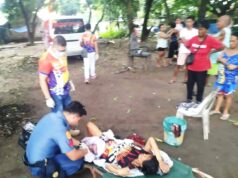CITY OF SAN FERNANDO – As A(H1N1) which used to be known as “swine flu” hits more areas in Central Luzon, another viral disease, this time affecting pigs, has already killed 760 of the animals as it spread to 15 towns in this province and jumped to five more towns in Bulacan.
A report furnished to Punto by Pampanga provincial veterinarian Dr. Augusto Baluyut said of Pampanga’s 21 towns, excluding Angeles City, only the towns of Floricablanca, Mabalacat, Magalang, Macabebe, and Masantol have not been affected by the so-called porcine reproductive respiratory syndrome (PRRS) which was first reported in San Simon town last May 1.
Bulacan provincial veterinarian Dr. Ma. Gloria Carillo said that in her province, PRRS as well as other ailments have already reached the towns of Calumpit, Guiguinto, Baliwag, Pulilan, and Plaridel. Some of the pigs were reported with hog cholera and other “common ailments”.
Both Baluyut and Carillo said that their reports were mostly from backyard raisers, as no reports from commercial raisers were immediately available. They said, however, that commercial raisers were unlikely to have been seriously affected as most of them have enough resources for the vaccination of their animals.
Dr. Romeo Manalili, chief veterinarian of the Department of Agriculture in Central Luzon, said that more vaccines are being awaited by swine raisers from the Bureau of Animal Industry (BAI) amid efforts to contain the spread of the viral disease.
Baluyut said that the disease seemed to have come from Pangasinan and then penetrated Bulacan through its boundary with Pampanga in the area of Candaba.
He said that in Pampanga, 3,138 pigs were confirmed to have contracted PRRS. A total of 760 of them have died, he said.
“We are still awaiting from BAI replenishment of vaccines against PRRS because some swine raisers who are not affected could vaccinate their animals,” he said.
He noted that PRRS in Pampanga could not have spread had his office been informed about it immediately. “It was first observed in San Simon town last May 1 but it was reported to us only on May 13 or 14,” he recalled.
In Bulacan, Carillo said that of at least 139 pigs examined, only six tested positive for PRRS while the others were found to have been afflicted with other ailments such as cholera. She described PRRS cases in her province as insignificant.
Carillo and Baluyut said, however, that the situations in their provinces are “under control”.
Records show that in the United States, PRRS is estimated to cost the pig industry $600 million a year.
The disease syndrome was first recognized in the USA in the mid 1980’s and was called mystery swine disease
An outbreak of the reproductive form of PRSS can last between 1 to 4 months, depending on the farm and the health of the pigs. However, once it has got into weaning piglets, PRRS can become chronic, resulting in above normal rate of deaths of up to 25 per cent and increased risk of other diseases including E.coli, Salmonella and swine flu, the veterinarians said.
A report furnished to Punto by Pampanga provincial veterinarian Dr. Augusto Baluyut said of Pampanga’s 21 towns, excluding Angeles City, only the towns of Floricablanca, Mabalacat, Magalang, Macabebe, and Masantol have not been affected by the so-called porcine reproductive respiratory syndrome (PRRS) which was first reported in San Simon town last May 1.
Bulacan provincial veterinarian Dr. Ma. Gloria Carillo said that in her province, PRRS as well as other ailments have already reached the towns of Calumpit, Guiguinto, Baliwag, Pulilan, and Plaridel. Some of the pigs were reported with hog cholera and other “common ailments”.
Both Baluyut and Carillo said that their reports were mostly from backyard raisers, as no reports from commercial raisers were immediately available. They said, however, that commercial raisers were unlikely to have been seriously affected as most of them have enough resources for the vaccination of their animals.
Dr. Romeo Manalili, chief veterinarian of the Department of Agriculture in Central Luzon, said that more vaccines are being awaited by swine raisers from the Bureau of Animal Industry (BAI) amid efforts to contain the spread of the viral disease.
Baluyut said that the disease seemed to have come from Pangasinan and then penetrated Bulacan through its boundary with Pampanga in the area of Candaba.
He said that in Pampanga, 3,138 pigs were confirmed to have contracted PRRS. A total of 760 of them have died, he said.
“We are still awaiting from BAI replenishment of vaccines against PRRS because some swine raisers who are not affected could vaccinate their animals,” he said.
He noted that PRRS in Pampanga could not have spread had his office been informed about it immediately. “It was first observed in San Simon town last May 1 but it was reported to us only on May 13 or 14,” he recalled.
In Bulacan, Carillo said that of at least 139 pigs examined, only six tested positive for PRRS while the others were found to have been afflicted with other ailments such as cholera. She described PRRS cases in her province as insignificant.
Carillo and Baluyut said, however, that the situations in their provinces are “under control”.
Records show that in the United States, PRRS is estimated to cost the pig industry $600 million a year.
The disease syndrome was first recognized in the USA in the mid 1980’s and was called mystery swine disease
An outbreak of the reproductive form of PRSS can last between 1 to 4 months, depending on the farm and the health of the pigs. However, once it has got into weaning piglets, PRRS can become chronic, resulting in above normal rate of deaths of up to 25 per cent and increased risk of other diseases including E.coli, Salmonella and swine flu, the veterinarians said.



